Humans 2.0
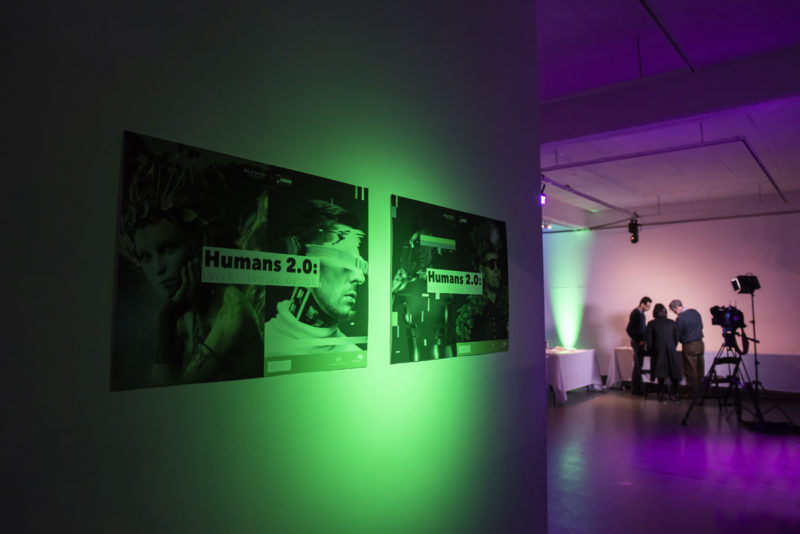
How will the humans of the future live their lives? Humans 2.0 was an event to step into the future for a moment. Filled with story-telling, scientific speculation, and experiences, it allowed people to jump from the present into the future and revealed what may be to come.
The evening of postulations and speculations began with Tom Lang’s vision of a utopian future: humans invent advanced artificial intelligence (AI) technology that provides us with free energy, teleportation, good education and healthcare systems, and the solution to global warming. With no problems left to solve and AI to do all their work for them, humans indulge in frivolous recreation and stop having children altogether. When the last human dies – tended to by their AI servants – the machines no longer have purpose and hibernate, ending the human race and their creations.
Throughout the night, people were invited to ‘dance like no one is watching’ as part of PHORIA’s immersive experience. Joseph Purdam, Co-Founder of PHORIA, shared his vision of a place of calm in which people are able to express themselves freely, and eliminate their anxiety and stress. He designed a space for people to augment their own environment by dancing as part of the seasonal elements: cherry blossoms, autumn leaves, snowflakes, etc, and to (literally) shake off all their negative feelings. Continuing the dancing theme, Silverpond provided an AI dancing platform. Machine learning allows AI to create its own rules on how something should be done – including dance moves. Based on 100 hours of online Zumba training, Susie Sheldrick’s dancing AI watched people dancing and transformed their daggiest dance moves into something greater. AI is already here in 2018 and it’s a pretty good dancer!

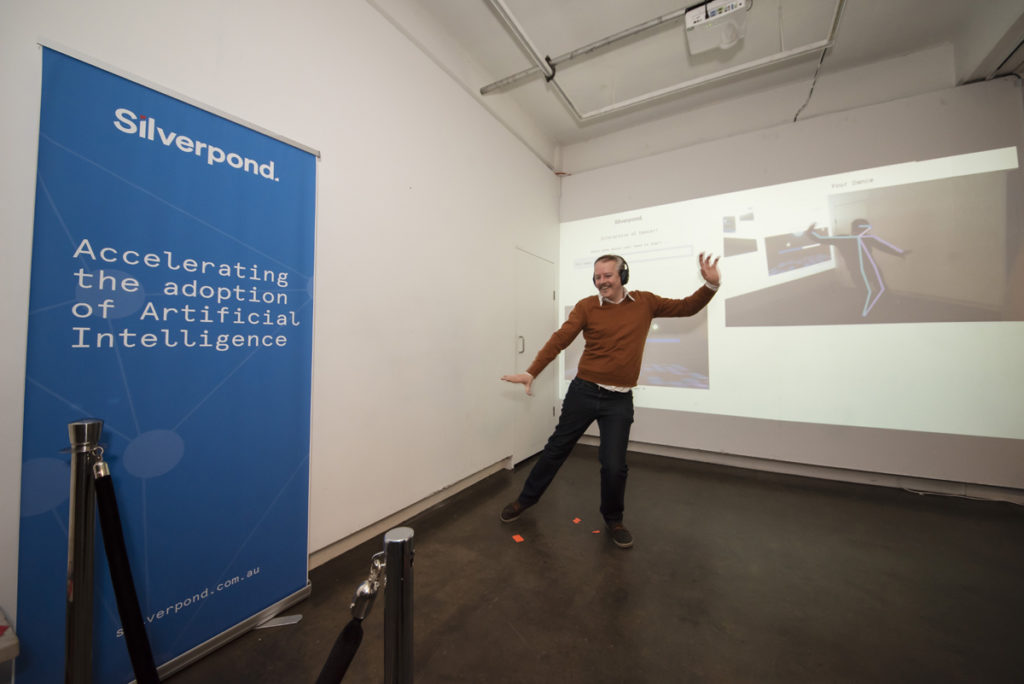
Former Pixar technical director and 3D artist, Stephanie Andrews, is excited by the potential of virtual reality (VR) technology to expand our imagination. VR, as Stephanie Andrews views it, allows people to create places and inhabit them, and develop our ability to think and imagine. After spending hours immersed in her work at Pixar playing with shadows and lights, she wanted to pick up shadows and move them around in the real world. To her, perception is ‘incredibly malleable’ and gave people the opportunity to view multiple slices of reality at a time as ‘different perspectives on one canvas’ with VR. The Hackathon Queen, Michelle Mannering, wonders whether we may eventually be completely immersed in the virtual world. She has discussed with medical professionals the possibility to combine medical technology used for life support with VR so that we can live completely inside a digital space, creating our own worlds and playing with our own set of rules to do things that we can’t do in the physical world.
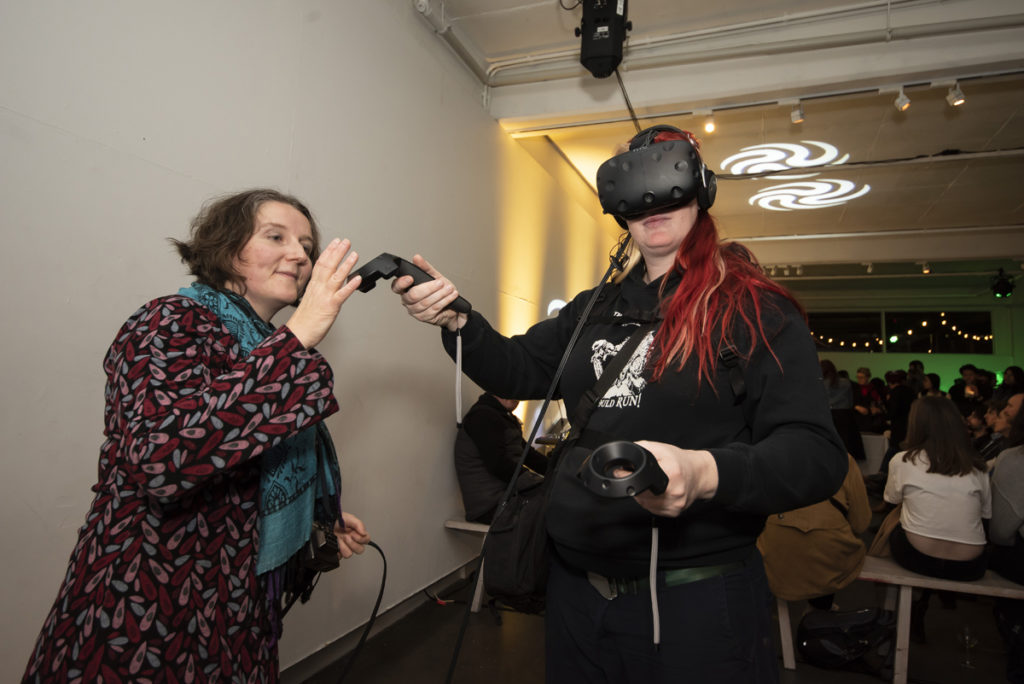
Dr David Farmer speculated what it might mean to be dead or alive in the future. He set up voting stations for participants to decide whether they considered, for example, a human brain connected to a machine, or a robot with a personality, to be “alive”. The principle behind life has shifted over the years: from the 18th century idea that a vital spark of electricity animates the body based on experiments applying an electrical charge to a cadaver’s neck could initiate movement, to the idea of consciousness being the difference between life and death. The Humans 2.0 poll certainly emphasised that we currently have trouble agreeing on what is “living”. As our society increasingly mixes technology with nature, especially with regards to bionic medical advancements, and the development of robotics and AI, we are going to be compelled to evolve our concept of the difference between life and death.
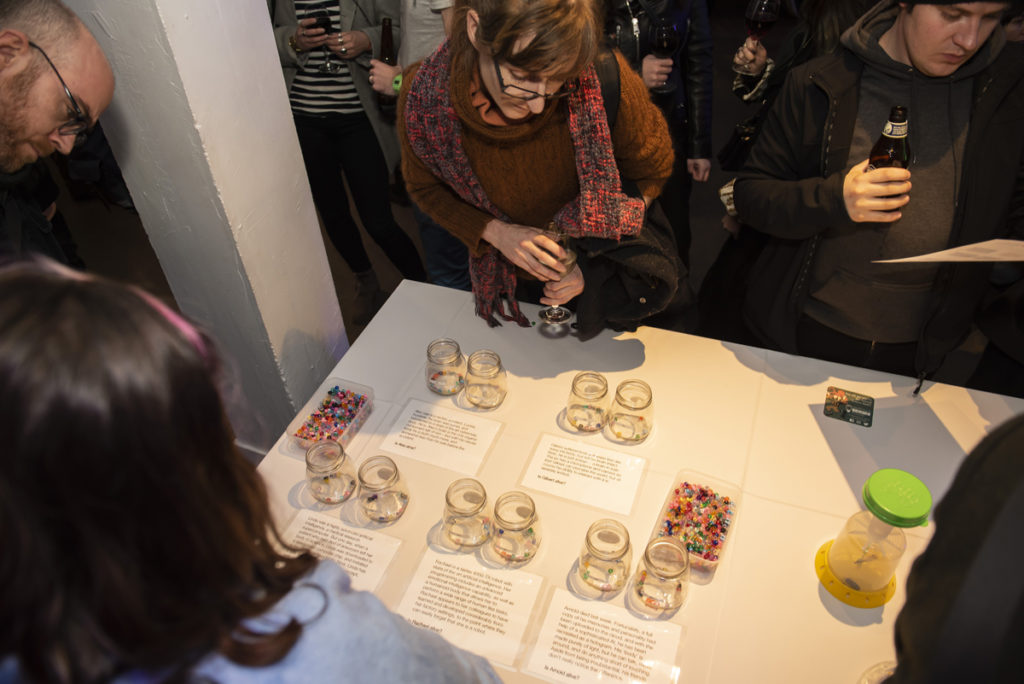
Dr Chris Gyngell, Research Fellow in Biomedical Ethics at The University of Melbourne, shared his concern for our ‘increasingly medicalised world’. In the future, perhaps nearly every child will be conceived with the help of artificial reproduction (e.g. IVF), brought into the world by caesarean section, immediately placed on supplements and medications to control normal body functions, and develop cancer by middle-age. With the increasing efficacy, reach, and our reliance on medical advances, humans are stopping the process of natural selection. Dr Gyngell provided the example of wearing glasses: vision problems were uncommon in the hunter-gather days, however with the easy fix of buying glasses nowadays, those with vision impairment can easily pass on their genes. He advised that our genetic health may deteriorate over generations as we increasingly rely on technology and medications, and we may have to adopt a more controversial strategy such as gene editing to keep our independence.
Alongside an increasing reliance on glasses, we have also seen the development of bionic eye technology. Dr Chris McCarthy described the bionic eye being used to restore vision by transmitting images taken by cameras directly to implants in the brain or retina. He also told of artificial and natural vision coming together with this bionic eye, as sighted people decide to augment their already 20/20 vision to detect light wavelengths beyond the visible spectrum, see new colours, and have in-built thermo-sensing. However, he cautioned that similar to applications on phones and tablets, there may be the issue of advertisements embedded into ‘cheaper’ versions of the bionic eye software, but unlike on a screen in front of you, you can’t look away from an ad that is imprinted into your mind.
Despite these warnings, ‘it’s human nature to seek improvement’ – whether it be physical or expanding knowledge. Dr Sarah Benson, Swinburne University of Technology, studies pharmaceutical cognitive enhancer substances and has seen an increasing reliance on them. As well as medications used for ADHD and narcolepsy treatment, caffeine and ginseng, classed as cognitive enhancers, are taken on a daily basis by many around the world. Usage of cognitive enhancer medicative drugs is currently illegal but increasing nonetheless, and Dr Benson wonders if they’ll perhaps become commonplace in the future alongside caffeine, especially as their use may be much safer if made legal and regulated thoroughly. In the future, cognitive enhancers may be added to alcohol so as to limit cognitive impairment, used to boost reaction times when driving, or used to delete memories in cases of trauma and addiction. The possibilities are endless and we may one day have a range of drugs that we can use to improve our performance in various tasks.
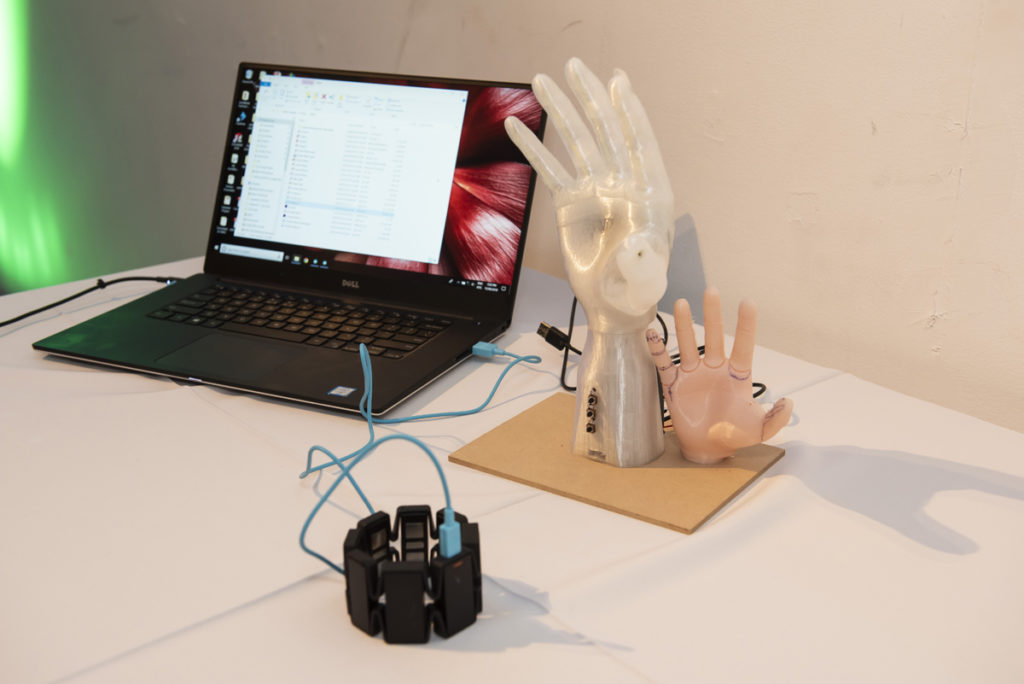
It is not all doom and gloom in the medical field, as Professor Elena Ivanova, RMIT, has created antibacterial surfaces based on the structure of cicada wings, lotus leaves, and shark fins that may overcome the current global antimicrobial resistance crisis. Bacteria continue developing resistance to new antibiotic drugs, but her surfaces to be used in filters, medical implants, etc. are lined with nanopillars that can physically rupture bacteria upon contact, not giving them a chance to adapt and survive. In addition, Dr Alireza Mohammadi, University of Melbourne, showed off his prototype robotic hand that can pick up objects and mimic movements of the other hand. He is creating a stronger, more dextrous, and sensitive hand that has many more input signals in the arm than current artificial hands that only have grasping functions. He wonders if one day his bionic hand may have much better manipulation that people may decide to chop off their own hand in favour of a robotic one! Designer and RMIT academic Dr Leah Heiss also displayed her fashionable devices that aim to save lives. From a necklace that senses cardiac output and sends information to cardiologists, hearing aids faceted as crystals, and a wedding ring with nanoneedles to administer drugs into the blood, she is ensuring that healthcare technologies and devices of the future will not be ‘ugly nor beige’, but rather part of our emotions and character.
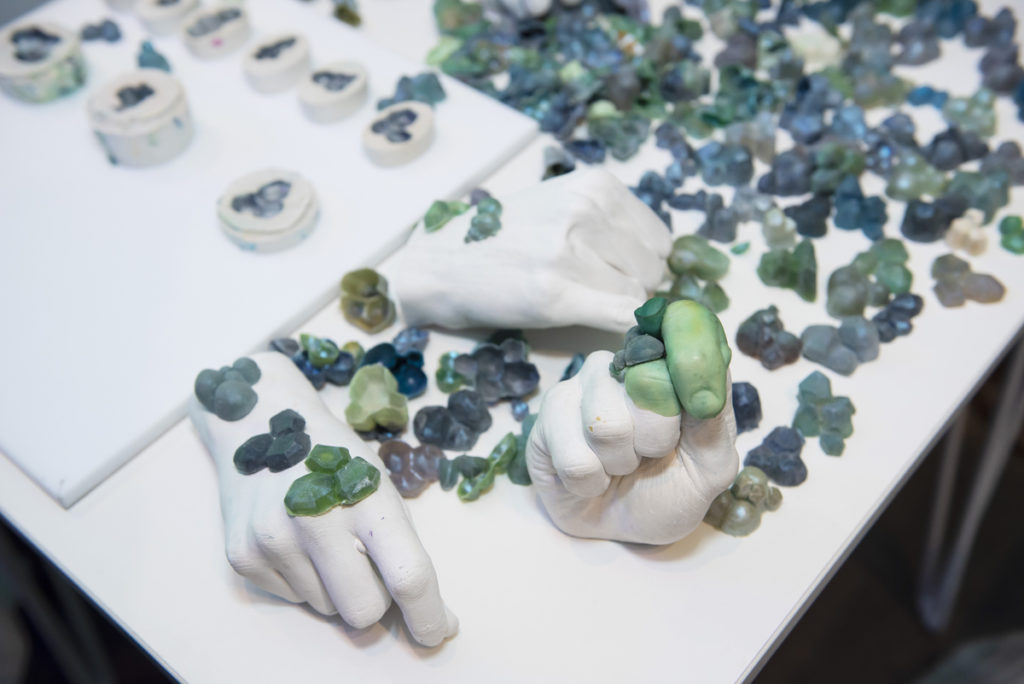
In amongst the activity, people enjoyed the catering provided by Charcoal Lane. Chef Greg Hampton’s food is heavily influenced by the food of indigenous Australians. On the menu was wallaby, aniseed and lemon myrtle quiche, and more – taking in Aboriginal’s understanding of food and the Australian landscape. With a booming population, more effort is pumped into crops as we try to grow the wrong sorts of food for our land. Greg Hampton urged that from a sustainability point of view, ‘the only way to have food for the future, is to look back into the past’, and that we should look to native plants to be our main food source. As they enjoyed their “bush-tucker”, guests were also able listen to the serene sounds of animal calls and sounds recorded in the rivers around Brisbane thanks to sound technologist Dr Tony Gifford’s immersive installation, developed in Monash University’s SensiLab.
People weren’t only fed for the day, but also for life – or as long as their potato plant to take home lives. Dr Chris Williams and his horticulture students from The University of Melbourne, guided a session on potato potting as he believes that gardening will continue to be an integral part of society and an important, sustainable source of food. He believes that even in 100 years’ time access to good urban green spaces for gardening will be vital to provide physical contact with plants and soil, which has been demonstrated to provide multiple health benefits, and to feed ourselves.
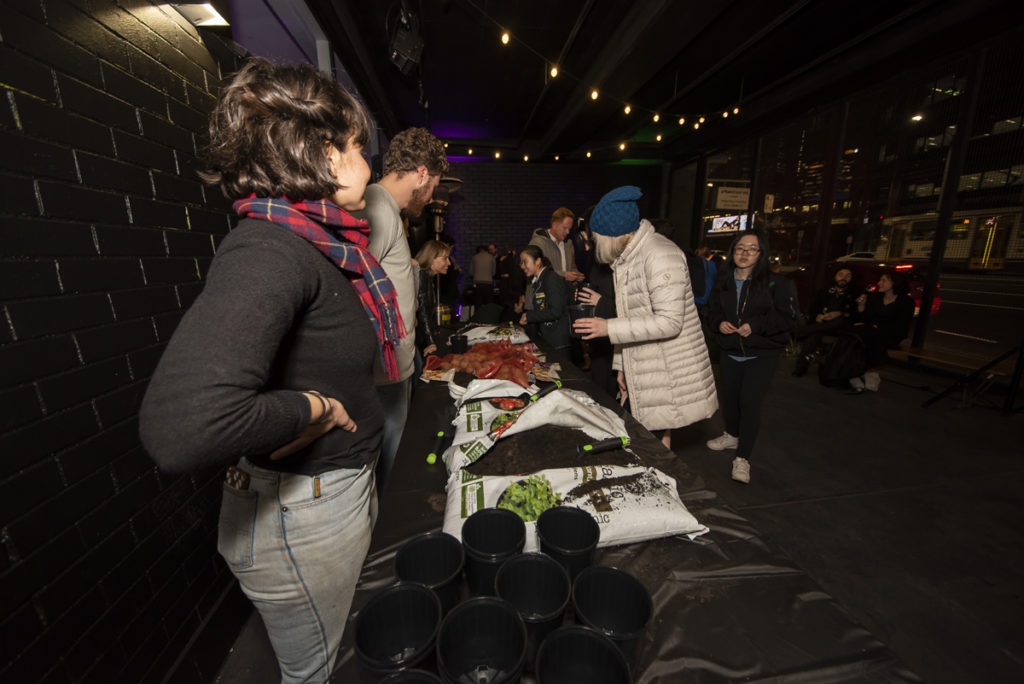
You may wonder how we’ll get around in the future – did all those sci-fi films with pods get it right? Zac McClelland is frustrated with the slow movement of current transportation and the hundreds of people we share our public transport system with, and is therefore developing Hyperloop: a ‘human spit-ball machine’ that can shoot people through a vacuum at up to 1200km/h. In the future we may be able to travel anywhere in the world in no time at all, and might even be able to pop to the moon for a weekend getaway.
Tom Lang concluded the night with a dystopian version of the future: a zombie apocalypse, robot judgement day, nuclear Armageddon, climate change, and viral pandemics leaves the Earth as a scorching, radioactive wasteland separated by toxic oceans filled with plastic bottles that will never break down. Humans are confined to either New Zealand or Greenland, where they survive as scavengers for thousands of years, not knowing the other population exist.
The evening left everyone wondering what will the future be? While many of us may not be around to see the day the world ends, we can’t help but wonder what Humans 2.0, the people of the future, may be like and how they’ll live their lives. Que sera sera!
